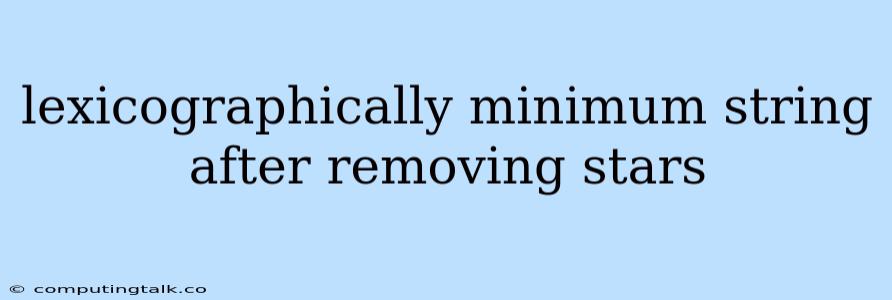The problem of finding the lexicographically minimum string after removing stars is a common challenge in computer science, particularly in areas dealing with string manipulation and algorithms. This problem involves processing a string that contains special characters, represented by asterisks (*), and determining the smallest possible string that can be formed after removing all the stars. Let's delve into the details of this problem and explore effective approaches for finding the solution.
Understanding the Problem:
Imagine you have a string like "abcd**efg". The goal is to find the smallest possible string you can create by removing all the '' characters while maintaining the order of the remaining characters. In this example, the lexicographically minimum string would be "abcdefg."
Approaches to Find the Lexicographically Minimum String
-
Stack-Based Approach: One common approach involves using a stack to efficiently manage the characters.
-
Algorithm:
- Initialize an empty stack.
- Iterate through the input string from left to right.
- For each character:
- If the character is not a star ('*'), push it onto the stack.
- If the character is a star ('*'):
- If the stack is not empty, pop the top element from the stack.
- After processing the entire string, pop all the elements from the stack and concatenate them to form the final string.
-
Example:
- Input: "abcd**ef*g"
- Stack: ['a', 'b', 'c', 'd', 'e', 'f', 'g'] (After processing the string)
- Output: "abcdefg"
-
-
Recursive Approach: This approach utilizes recursion to process the string and make decisions about removing stars based on the current state of the string.
-
Algorithm:
- Define a recursive function that takes the input string as a parameter.
- Base case: If the string is empty, return an empty string.
- If the first character is a star ('*'):
- Return the result of the recursive call on the substring starting from the second character.
- Otherwise, compare the current character with the first character of the string after removing the next star.
- If the current character is lexicographically smaller, return the current character concatenated with the result of the recursive call on the remaining substring.
- Otherwise, return the result of the recursive call on the remaining substring (after removing the next star).
-
Example:
- Input: "abcd**ef*g"
- Recursive calls:
lexicographicallyMinimum("a*bc*d**ef*g")->lexicographicallyMinimum("bc*d**ef*g")->lexicographicallyMinimum("bcd**ef*g")-> ... ->lexicographicallyMinimum("g")-> "g"
- Output: "abcdefg"
-
Choosing the Right Approach
The choice between the stack-based and recursive approach depends on factors like coding style, familiarity with data structures, and the specific requirements of the problem. The stack-based approach is generally considered more efficient for larger input strings due to its iterative nature and ability to directly manipulate the characters.
Handling Edge Cases
It's crucial to handle edge cases during the implementation. Here are some key scenarios to consider:
- Empty String: If the input string is empty, the output should also be an empty string.
- Only Stars: If the input string only contains stars, the output should be an empty string.
- Leading Stars: If the input string starts with stars, these stars should be removed before processing the rest of the string.
Example Code (Python)
def lexicographicallyMinimum(s):
stack = []
for char in s:
if char != '*':
stack.append(char)
else:
if stack:
stack.pop()
return ''.join(stack)
# Example usage:
input_string = "a*bc*d**ef*g"
output_string = lexicographicallyMinimum(input_string)
print(f"Input: {input_string}")
print(f"Output: {output_string}")
Conclusion
Finding the lexicographically minimum string after removing stars is a problem that can be solved using various algorithms and approaches. Understanding the concept of lexicographical ordering and the logic behind different techniques is crucial for developing efficient solutions. By analyzing the problem carefully and considering edge cases, you can write code that reliably produces the desired output.
